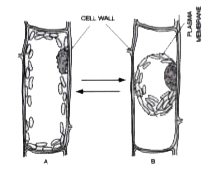Cells at the end of prophase, when viewed under the microscope do not show_________ .
Golgi complexes, endoplasmic reticulum, nucleolus and the nuclear envelop
Only nuclear envelope
Only endoplasmic reticulum
Only nucleolus
The correct Answer is:A
To answer the question, "Cells at the end of prophase, when viewed under the microscope do not show_________," we will analyze the events that occur during prophase in mitosis.
1. Understanding Prophase: Prophase is the first stage of mitosis, where significant changes occur in the cell.
2. Nuclear Envelope Breakdown: At the end of prophase, the nuclear membrane (nuclear envelope) begins to break down completely. This allows the chromosomes to be released into the cytoplasm.
3. Chromosomal Condensation: During prophase, chromatin condenses to form distinct chromosomes, making them more visible under the microscope. By the end of prophase, these chromosomes are fully condensed.
4. Disappearance of Organelles: Key organelles such as the endoplasmic reticulum (ER), Golgi apparatus, and nucleolus begin to disappear during prophase. By the end of prophase, they are no longer visible.
5. Movement of Centrioles: The centrioles move to opposite poles of the cell, which is a characteristic feature of prophase.
6. Conclusion: Given the breakdown of the nuclear envelope and the disappearance of organelles, the structures that are not visible at the end of prophase include the nuclear envelope, nucleolus, and endoplasmic reticulum. However, the question specifically asks for one item that is not visible.
7. Final Answer: Therefore, the correct completion of the statement is: "Cells at the end of prophase, when viewed under the microscope do not show the nucleolus."
Topper's Solved these Questions
- BIOLOGY AT A GLANCEBOOK - ALLENCHAPTER - BIOLOGY AT A GLANCEEXERCISE - Plant physiology
64 Videos
- BIOLOGY AT A GLANCEBOOK - ALLENCHAPTER - BIOLOGY AT A GLANCEEXERCISE - Reproduction In Plants
25 Videos
- BIOLOGY AT A GLANCEBOOK - ALLENCHAPTER - BIOLOGY AT A GLANCEEXERCISE - Biomolecule
29 Videos
- BIODIVERSITY AND CONSERVATIONBOOK - ALLENCHAPTER - BIODIVERSITY AND CONSERVATIONEXERCISE - S
18 Videos
- BIOLOGY AT A GLANCE (ZOOLOGY )BOOK - ALLENCHAPTER - BIOLOGY AT A GLANCE (ZOOLOGY )EXERCISE - EXERCISE
207 Videos
Similar Questions
Meristematic cells do not show
View SolutionCancerous cells do not show
View SolutionThe cross-section of a plant material showed the following features when viewed under the microscope
(a) The vascular bundles were radially arranged
(b) Four xylem strands with extrach condition of protoxylem. To which organ should it be assigned ?
View SolutionTwo cross sections of stem and root appear simple, when viewed by naked eye. But under microscope they can be differentiated by
(a) Exarch condition of root and stem
(b) Endarch condition of stem and root
(c) Endarch condition of root and exarch condition of stem
(d) Endarch condition of stem and exarch condition of root
View SolutionChromosomes are first visible under light microscope during
View SolutionWhen a colloidal sol is observed under a microscope we can see,
View SolutionWhen a colloidal sol is observed under a microscope we can see,
View SolutionMinimum cell size seen under light microscope is
View SolutionMost cells are microscopic.
View SolutionGiven below are diagrams of plant cells as seen under the microscope after being placed in two different solutions :

From the solutions given in brackets (water, strong sugar solution , 1% salt solution) name the solution into which :
(1) Cell A (2) Cell B was placed before being viewed under the microscope.
View Solution
